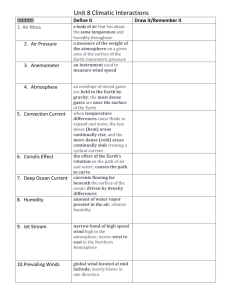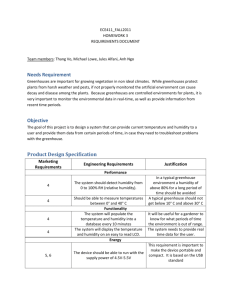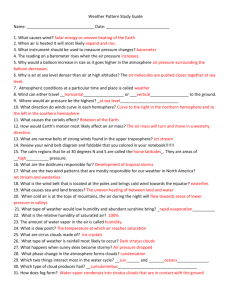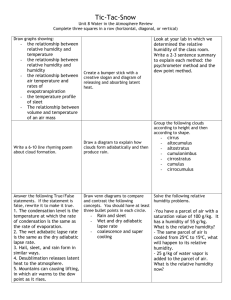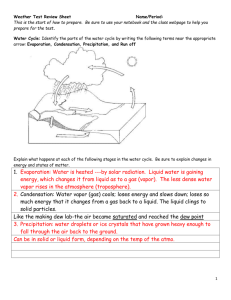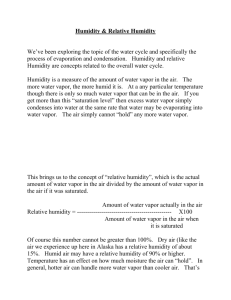Humidity - Dordt College Homepages
advertisement
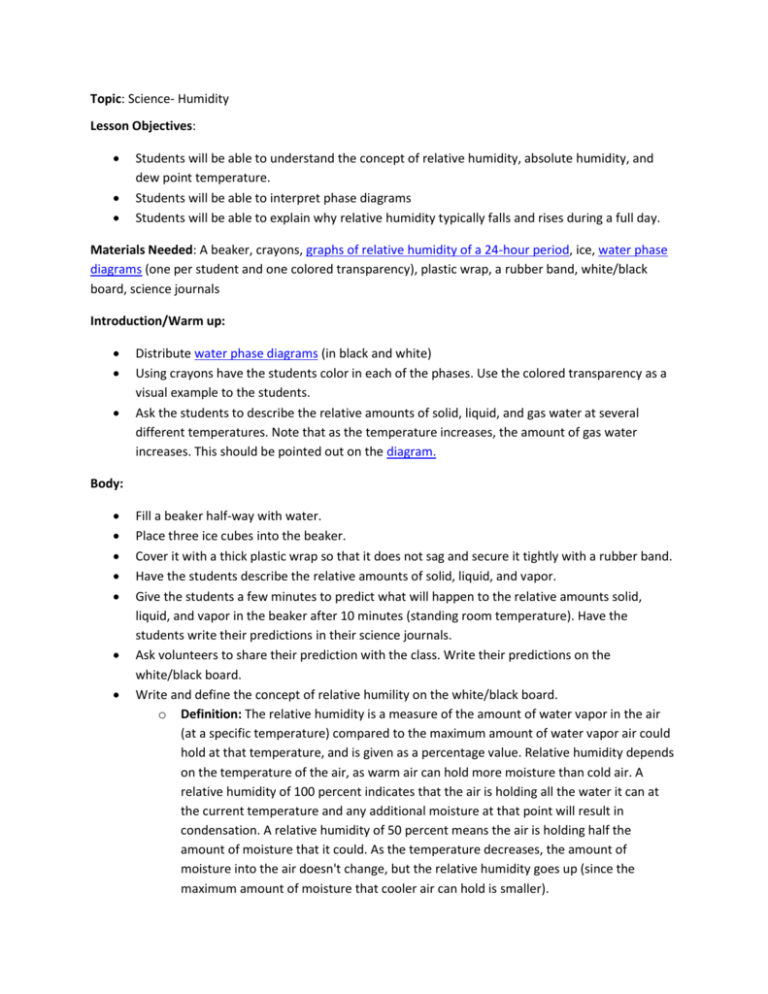
Topic: Science- Humidity Lesson Objectives: Students will be able to understand the concept of relative humidity, absolute humidity, and dew point temperature. Students will be able to interpret phase diagrams Students will be able to explain why relative humidity typically falls and rises during a full day. Materials Needed: A beaker, crayons, graphs of relative humidity of a 24-hour period, ice, water phase diagrams (one per student and one colored transparency), plastic wrap, a rubber band, white/black board, science journals Introduction/Warm up: Distribute water phase diagrams (in black and white) Using crayons have the students color in each of the phases. Use the colored transparency as a visual example to the students. Ask the students to describe the relative amounts of solid, liquid, and gas water at several different temperatures. Note that as the temperature increases, the amount of gas water increases. This should be pointed out on the diagram. Body: Fill a beaker half-way with water. Place three ice cubes into the beaker. Cover it with a thick plastic wrap so that it does not sag and secure it tightly with a rubber band. Have the students describe the relative amounts of solid, liquid, and vapor. Give the students a few minutes to predict what will happen to the relative amounts solid, liquid, and vapor in the beaker after 10 minutes (standing room temperature). Have the students write their predictions in their science journals. Ask volunteers to share their prediction with the class. Write their predictions on the white/black board. Write and define the concept of relative humility on the white/black board. o Definition: The relative humidity is a measure of the amount of water vapor in the air (at a specific temperature) compared to the maximum amount of water vapor air could hold at that temperature, and is given as a percentage value. Relative humidity depends on the temperature of the air, as warm air can hold more moisture than cold air. A relative humidity of 100 percent indicates that the air is holding all the water it can at the current temperature and any additional moisture at that point will result in condensation. A relative humidity of 50 percent means the air is holding half the amount of moisture that it could. As the temperature decreases, the amount of moisture into the air doesn't change, but the relative humidity goes up (since the maximum amount of moisture that cooler air can hold is smaller). Explain why the concept of relative humidity, rather than absolute humidity, is used by weather experts. o Because relative humidity is a ratio of the actual water vapor content of the air to the amount of water vapor needed to reach saturation. Absolute humidity is the mass of water vapor contained in a given volume of air. After the 10-minute period, have the students describe the relative amounts of solid, liquid, and vapor in the beaker, and write their observations in their science journal. Ask the students to explain the result. Guiding the students will be necessary. Ask them prompting question such as: what happened to the temperature of the beaker? (warmer or colder) As the temperature increased, what happened to the relative amount of solid, liquid, and gas? (Less solid, more liquid) How can you use the phase diagram to explain the result? All of these questions might be useful for the students. Revisit students’ predictions. Remind students that all predictions, even the incorrect ones, are a valuable and necessary contribution to the scientific method. This will ensure that even if we haven’t found the correct answer yet, the students know they need to create a new hypothesis, keeping their old one in mind. Closure/Practice: Assign pairs. Distribute graphs showing relative humidity in a city, or several cities, during a 24-period. Ask the pairs to work together to write a paragraph in their science journals explaining how and why the relative humidity changes during a 24-hour period. Assessment: Ask pairs to share their explanations with the whole group. If no group provides a complete explanation, use guided questions to lead students. Here are a few questions to ask: o What happens to temperature during a 24-hour period? o Will the amount of moisture in the air radically change during a 24-hour period? o If the amount of moisture stays the same, what will happen to the relative humidity as temperature increases? The responses will not be formally graded; however this will display the competency of the students and whether or not they have met the lesson’s objectives. Have the students revise the explanation they wrote in their journals.


